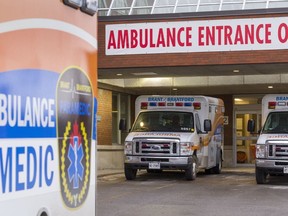
‘Back hall nurse program’ helps alleviate some stress

Article content
Brant-Brantford’s paramedic service is still seeing “code zero” events on a daily basis despite support from the municipal and provincial governments to help free up some ambulance capacity.
Advertisement 2
Article content
Through the pandemic and beyond, local paramedics often went without meal breaks to prevent code zeroes — a situation when no ambulance is available to respond to a call.
Article content
In this case, a nearby jurisdiction — Haldimand, Norfolk, Six Nations, Oxford or Hamilton — is asked to send one.
At a minimum, this translates to longer wait times for medical assistance. The worst-case scenario could be no timely ambulance response.
Last year, code zeroes happened a minimum of three times a day on average, Russell King, chief of Brant-Brantford Paramedic Services, told The Spectator. Now it’s trending down to less than two a day, he added.
In 2022, councils in the County of Brant and City of Brantford jointly approved an additional vehicle for the service, which helped to bring capacity down from 115 per cent at the end of last year, to 92 per cent as of the end of September.
Advertisement 3
Article content
Now, the local service is responding to an average of 2,459 monthly calls — about 163 less per month than last year.
On Wednesday, King told the county’s paramedic services committee that while code zeroes are down, the service is still facing lost time.
“For the last 24 days, we lost 15 per cent of our vehicle hours sitting in emergency department,” King told the committee, citing long off-load times — the time it takes to transfer patients into the hospital’s care.
To help combat this, the paramedic service and Brant Community Healthcare System (BCHS) introduced what is informally known as the “back hall nurse program.”
It transfers patients with stable vitals, who are not requiring monitors or immediate physician care, into the care of a nurse, who oversees six hallway beds — returning paramedics to the road.
Advertisement 4
Article content
The program has been running since February, but King said that it has yet to continuously run at full capacity because of staffing challenges at the hospital.
Alena Lukich, a spokesperson for BCHS, said hiring qualified nurses continues to be a challenge provincewide.
If critical vacancies come up in other areas of the hospital — for instance, a position needs to be filled in the ICU — they take priority, King said.
With an additional $628,000 in provincial funding, King said the hope is to have the program fully staffed and running around the clock in mid-November — just in time for prime cold and flu season.
But arriving by ambulance still won’t mean a shorter wait time for folks in non-urgent condition, King cautioned.
Advertisement 5
Article content
If patients fall under “fit to sit” criteria — meaning they are stable and able to sit on their own — paramedics will bring them to the waiting room. “Similar to if you took a taxi or had a family member drop you off at the hospital,” King said.
To help ensure patients who require life-saving medical attention can get it, King encouraged folks to take preventive measures, like getting flu and COVID shots.
Additionally, he said if there are medical issues that can be handled by walk-in clinics, urgent care centres, or family doctors, that can alleviate some of the strain on the emergency department and paramedic service.
“Any one, two, or five calls that we can divert a day will help the system,” he said.
Celeste Percy-Beauregard is a Local Journalism Initiative reporter based at the Hamilton Spectator. The initiative is funded by the Government of Canada.
Article content